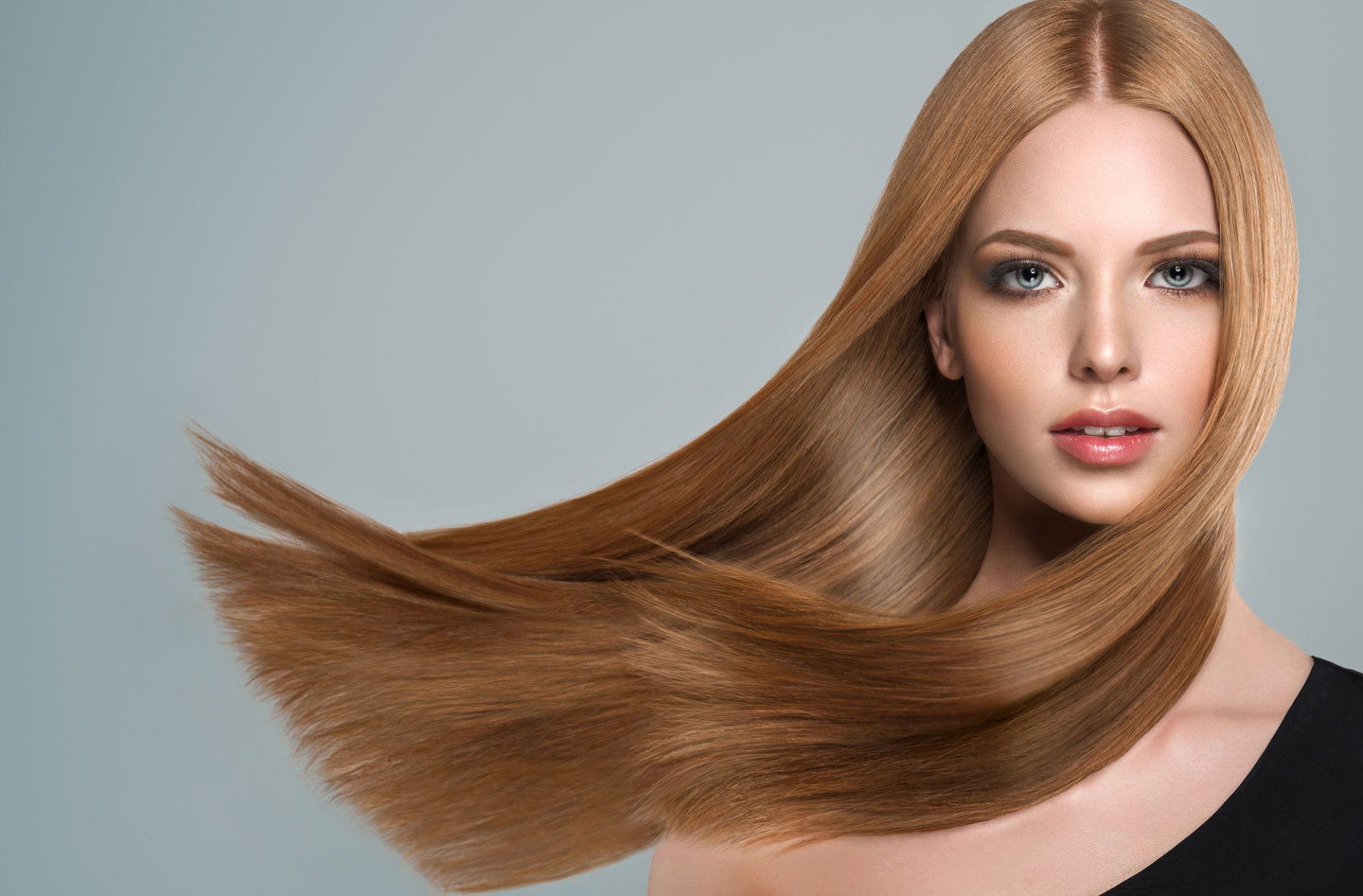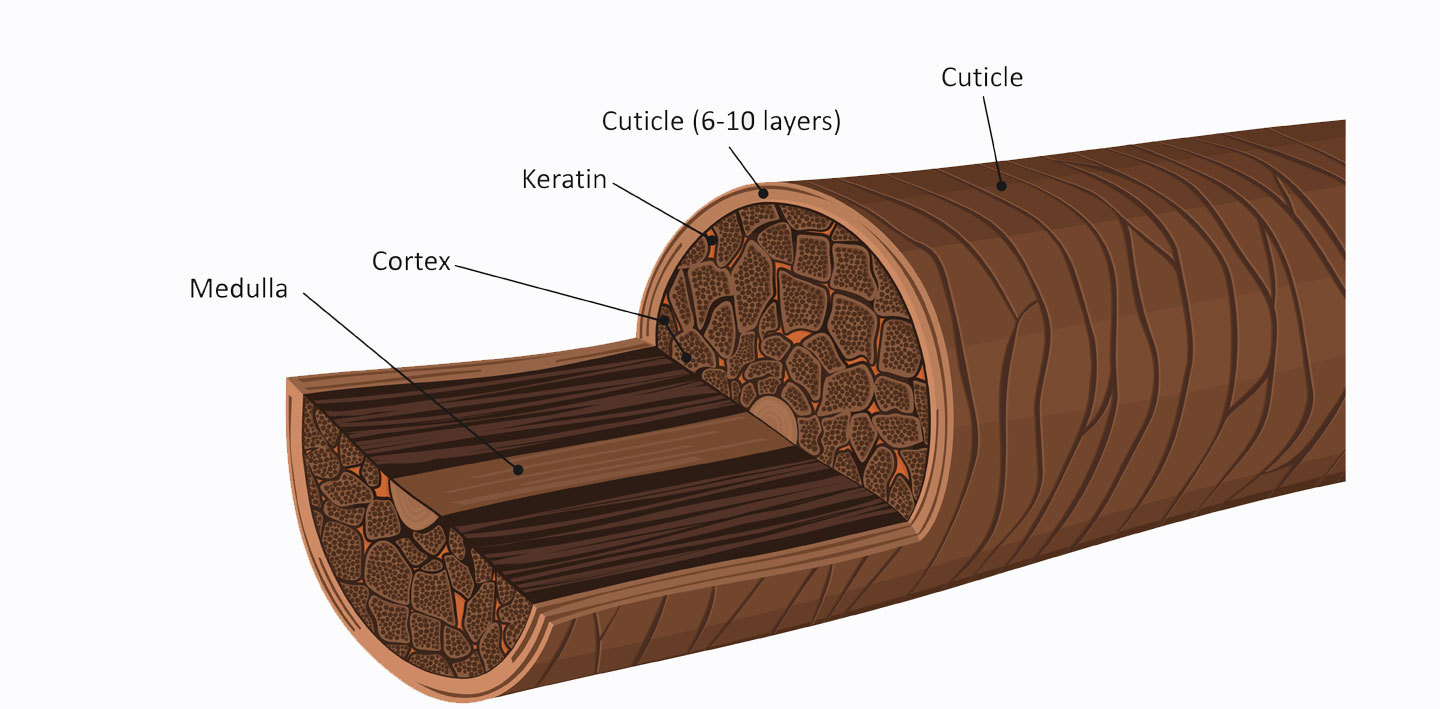 News
Articles & Recipes
Articles
Protein, The Stuff of Hair
News
Articles & Recipes
Articles
Protein, The Stuff of Hair
Protein, The Stuff of Hair

In terms of tensile strength, that is the strength of something being stretched, human hair is stronger than steel. That ability to be stretched is a key feature of human hair and is something we can trace back to the way the fibres are bonded together. Coming back to strength, we shouldn't think our hair is bullet proof though as when all aspects of strength are considered, human hair beats nylon thread but sits at only half the strength of silkworm silk and a mere six times weaker than spider silk. In case you are interested, steel comes in at double the strength of hair due to its ability to withstand squashing.
The stretchy element of hair is due to the disulphide bonds that form between keratin strands deep inside the cortex (under the cuticle). These bonds can be chemically altered using relaxers or perming solutions but when left alone they act like little bridges, binding springy keratin fibres together into a strong, ordered, structure. Curly hair tends to have more of these bonds than straight hair although there is some debate as to how and when these forms. It may be that the single keratin strands can get closer together to form these bonds due to the follicle being oval rather than round. This shape would produce a hair that is exposed to different chemical and physical forces on each side and that could lead to the formation of asymmetrical sulphide bonds rather than then all lining up evenly. Whatever the case, curly, wavy and straight hair has these bonds and they require some effort to break.
As well as disulphide bond have hydrogen and salt bonding in our hair, both of which contribute to the hair's overall strength. Most of us witness the power of these bonds on the hair on very humid days when people lucky enough to have a bit of curl turn into fuzz-balls! While that may be tiresome for them, there's no doubt that these bonds have their place for hair stylists and product developers alike once we understand them we can use them to our advantage.
Hydrogen bonds can be manipulated into shapes of our choosing using heated rollers, hairdryers or straighteners! Salt bonds are affected by the pH of our hair and as such, changing the pH with something mild like Apple Cider Vinegar can semi-relax these bonds, giving our hair a soft, conditioned feel and a little shine - shine happens when the cuticle is closed and lying flat.
Maintaining Keratin In Good Condition
Lifestyle choices, natural ageing, environmental stressors and illness can all take a toll on the hair. When we notice our hair has lost strength, shine and vitality, most of us turn to cosmetic products and treatments in a bid to repair or restore the hair back to its virgin strength. As around 85-90% of hair weight is protein, seeking protein treatments seems the logical step to take.
Not All Protein Is Created Equal
Arguably the best way to 'feed' your hair is with more hair, the issue with that is in finding a donor that is happy to have you chop off their good hair and process it in a way that enables it to stick to and repair yours! After human hair, the next best thing in terms of bio-compatibility is animal keratin. It is typical to find cosmetic grade keratin sourced from foul feathers but research is also going on into the use of pig and other animal hair as keratin-like protein sources. As much as these animals don't have to die to share their keratin with us, there has been a growing distaste for utilising animal derived ingredients in cosmetic preparations and as such, many brands turn to vegetables for their protein fix. While that seems a natural and logical thought progression, the truth of the matter is that we are not vegetables and veggie protein may not give our hair what it wants and needs, at least not without a little bit of help anyway...
Before we go on it is important to acknowledge that keratin and, indeed, all proteins are ultimately made up of amino acids. These amino acids may be acidic, neutral or basic in nature, may be water loving or water hating, big or small, branched in structure or linear. When looking at protein sources it is typical to drill down to the amino acid level to see what the protein is made of. From analysing a proteins amino acid structure, we can get some idea of how that protein may perform when turned into a hair care ingredient. For example, those disulphide bonds I talked about earlier, they rely on the amino-acid cysteine to help them create that bond. Human hair contains around 18% cysteine which is useful, other protein sources fall way short of that with only Oats coming anywhere close. But can we compare oat protein to keratin protein at an amino-acid level and expect the amino acids to be able to do their thing? No, not really.

Protein: The Shape of Things
Whole proteins such as those we find in nature (and typically eat) include oats, wheat, hemp, egg white and rice. If we just go down to the health food shop and buy whole foods, the proteins are not broken down into their composite amino acids there and then, instead they are in their natural protein state. Just as there are different families of amino acids, there are different families of proteins with different features and benefits based on their structure. One important feature of proteins is their water binding capacity, another is in their ability to form emulsions. If you study food chemistry you will be familiar with this because good water binding means tastier, less dried-out food after cooking and good emulsification means more stable, possibly more elastic foods when making, cooking and eating.
When we put whole proteins into our bodies our digestive system snips the proteins down using enzymes. These enzymes take what was a big protein chunk and digests them into individual amino acids. These individual amino acids can then do their magic. When we put a whole protein on the skin or hair, it can only go as far as the whole protein step, so we can't really judge a whole protein hair treatment on its amino acids, we have to judge it on its protein structure.
Material scientists have understood the limitations of whole proteins in the cosmetic realm for many years and we now tend to formulate with ingredients which we call hydrolysed proteins or amino acids blends. Where the amino acids have come from a specific material the ingredient will take on that name - Keratin amino acids, silk amino acids, soy amino acids etc. Where the protein is still whole but the protein part of the plant has been separated out from the other bits - sugars, oils, fibre etc, the ingredient may be called 'protein' - Rice protein, Soya protein. Where the amino acids have been manufactured independent of a specific protein source the ingredient may just be called 'amino acid' - Arginine, Lysine HCL etc. Understanding this is key to understanding what your ingredient will do, where it will sit on (or in) the cuticle and how it might feel.
Those making vegan hair care or hair care using whole foods may find issues with whole proteins. The main issue is that most proteins are quite good at binding moisture and while moisture isn't a bad thing per se, the hair is actually quite dry when compared to the skin and for good reason. Hair typically contains only 10-15% water and most of that is bound to the cuticle. Wet hair is substantially weaker and more vulnerable to breakage than dry hair. This makes sense when we remember that a good proportion of hair strength comes from those hydrogen and salt bonds, both of which are affected by moisture. If you choose to load up a product with proteins that bind large amounts of moisture to the hair, instead of strengthening it, you may well weaken it. While that is true, it is not that simple to work out what your protein source is going to do. Proteins are complex chemicals and they are rarely applied alone. The level of water in your formula, the formula pH, the presence of any charged ingredients including salt and the concentration of the protein plus how the product is manufactured, stored and used will all play their part in determining whether your product is good, bad or indifferent.
Do we need to put protein in our hair products?
If we ignore protein, we have only 15-20% of other stuff to play with in terms of moisturising, shine-enhancing, protecting and strengthening. While small in comparison to protein, this 15-20% still matters and it is here where we can explore the wide variety of oils, butters and waxes, herbal extracts, vitamins, colourants and environmental protection shields on offer. These ingredients can be used to further protect, enhance and balance hair chemistry in ways that build resilience and vitality even without any additional protein. However, they can't replace lost protein and protein loss is inevitable for most people at least some of the time.
Human hair grows at a rate of between 0.5-1.7cm per month so anyone with shoulder length hair will have been rocking those strands for a good couple of years at least. During that time the sun, hard water, pollution and other weathering will have taken its toll and led to a reduction of protein in the hair tips. This can be cosmetically attended to with hair oils and masks that close and smooth the cuticle but only a protein treatment can replenish that lost protein and restore the hair to its full strength.
The bottom line is that protein, in some shape or form is needed for most people at least some of the time. The exact detail of how, why, when and where is worth spending a little bit more time uncovering!
Want to learn more?
If, like me you find this subject fascinating why not join us at one of our interactive hair science and formulating classes.
Our Urban haircare class looks at how protein can be integrated into styling products for runway ready hair whatever the environment while our Intensive Care class looks at how to select the right protein for your hair type, lifestyle and application preference. Both classes cover all three aspects of hair nutrition - protein, oil and water - and provide attendees with the opportunity to get hands-on and creative as you create a range of six products under the guidance of our cosmetic chemist. As haircare is such an applied science these courses are co-facilitated by industry experts so that you don't just discover how to make effective hair products, you also learn how to use them. See our website for more details, dates and our booking form!
Amanda Foxon-Hill
